
FRIDAY, APRIL 7, 2023 EMERALD | PAGE 1 Week of Welcome Edition NEWS: LEECH, OTHER CANDIDATES, RUN FOR WARD 7 CITY COUNCILOR PG 4 • OPINION: IVERSON: DESTIGMATIZE THE COWBOY HAT PG 12 • SPORTS: OREGON GOLF LEADS AFTER ROUND 1 OF 33RD DUCK INVITATIONAL PG 16 APRIL 7, 2023 Emerald Media UO’S NEW PRESIDENT SCHOLZ IS READY TO SCHOOL JOHN KARL SHOLZ STEPS UP TO TAKE FLIGHT AS UO’S 19TH PRESIDENT

PAGE 2 EMERALD | FRIDAY, APRIL 7, 2023
NEWSROOM
EDITOR IN CHIEF
Hannarose McGuinness
PRINT MANAGING EDITOR


Brandon Roth
DIGITAL MANAGING EDITOR
Sarah Matlick
NEWS EDITORS
Alexis Weisend
Gavin Gamez
Caleb Barber
A&C EDITORS
Krista Kroiss
Evan Reynolds
SPORTS EDITORS
Aaron Heisen
Mojo Hill
OPINION EDITORS
Emma J Nelson
Sophia Cossette
PHOTO EDITOR Maddie Stellingwerf
SENIOR PHOTOGRAPHER
Ian Enger
DESIGN EDITOR
Liz Blodgett
COPY CHIEF
Amanda Lurey
ASSOCIATE COPY EDITORS
Dylan Farrell Logan Robertson
VIDEO EDITOR Troy Munson
PODCAST EDITOR

Jamie Diep
SOCIALS EDITOR
Jennifer Singh
VISUALS EDITOR
Julia Stalnaker
BUSINESS
PUBLISHER & PRESIDENT
Bill Kunerth X317 bkunerth@dailyemerald.com
VP OPERATIONS Kathy Carbone X302 kcarbone@dailyemerald.com
DIRECTOR OF SALES & DIGITAL MARKETING
Shelly Rondestvedt X303 srondestvedt@dailyemerald.com
CREATIVE & TECHNICAL DIRECTOR
Annie Smith X327 creative@dailyemerald.com
STUDENT SALES MANAGER
Amy Mendez
ACCOUNT EXECUTIVES
Riley Valle
Keaton Roberts
Max Goldenberg
Josh Delapena
ON THE COVER
UO selects John Karl Scholz as its 19th president (Courtesy of the University of Oregon).
FOR YOU
LOOK ONLINE
Student Recommends
BY EVAN REYNOLDS
BOOK RECOMMENDATION: “JUST MERCY’ BY BRYAN STEVENSON
Summary: I recommend “Just Mercy,” a memoir by Bryan Stevenson, an American attorney whose work has centered on overturning wrongful convictions and prohibiting the death penalty in the American criminal justice system. The novel makes a simple argument that, while we are all deserving of mercy, sentencing and imprisonment in America are designed to take mercy out of the equation, making communities of color particularly vulnerable. Stevenson’s earnest prose manages to create mass appeal –– whether you’re fascinated by the ins and outs of American judicial politics, or simply interested in stories of the human condition, this book will get you thinking and change the way you view justice and mercy.
Top viewed story in the past week: “Fisherman’s Market brings the flavors of the Pacific Northwest to Eugene with the freshest seafood around”

By Lauren Leone
(Kai Kanzer/Emerald)
Second most read story in the past week:
“Welcome back: Oregon’s star sprinter Micah Williams” by Keiji Patterson

(Molly McPherson/Emerald)
Voices of UO
Do you want your voice heard literally? Scan here to respond to our Voices of UO prompt with a brief voice message, and head to www. dailyemerald. com/ multimedia/ podcasts/ next week to listen to the replies!


We want to hear from you:
We want to hear from you: Email editor@dailyemerald. com to submit a tip or a letter to the editor. The ideal length for a letter
(Maisie Plew/Emerald)
For updated coverage of sports and digital-exclusive content, go to www.dailyemerald.com


FRIDAY, APRIL 7, 2023 | EMERALD | PAGE 3
VOL . 124, ISSUE NO. 65 GET IN TOUCH EMERALD MEDIA GROUP 1395 UNIVERSITY ST., #302 EUGENE, OR 97403 541.346.5511
Emerald
Daily
THE DAILY EMERALD
The Daily Emerald is published by Emerald Media Group, Inc., the independent nonprofit media company at the University of Oregon. Formerly the Oregon Daily Emerald, the news organization was founded in 1900.
is 200-500 words, but we publish letters of various lengths online.
Scan here or visit the Emerald’s social media to participate in our next Voices of UO.
are your thoughts on the new university
“What
president?”
AVAILABLE ON SPOTIFY, SOUNDCLOUD, APPLE PODCAST AND DAILYEMERALD.COM
(Photo courtesy of Even Reynolds)
CHECK OUT THE NEW PERSON OF INTEREST PODCAST
LEECH, OTHER CANDIDATES, RUN FOR WARD 7 CITY COUNCILOR
After Councilor Claire Syrett was recalled last September, Lyndsie Leech was appointed in her place. Now Leech is running for re-election, but not unopposed.
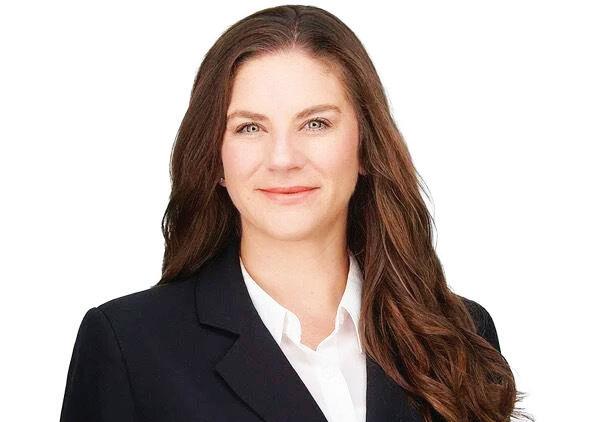 BY MATHIAS LEHMAN-WINTERS
BY MATHIAS LEHMAN-WINTERS
Eugene voters will be going to the polls to vote for the Ward 7 city council seat this May.
Last September, Councilor Claire Syrett was recalled, and in her place, Lyndsie Leech was appointed in December by the city council to serve the remainder of her term.
Leech said she believes her experience with grassroots organization and community-focused nonprofits has provided her with the necessary skills to serve on the city council.
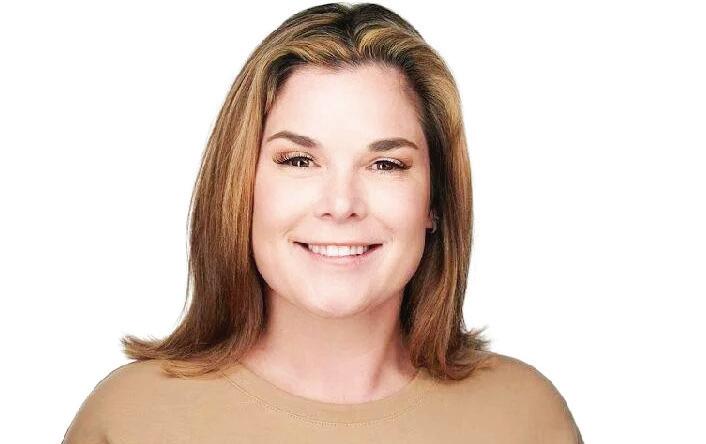
Leech has been a lifelong social worker, previously working with groups including Looking Glass Community Services, The Child Center, HIV Alliance and Food for Lane County.
Almost her entire professional career, up until her appointment to the city council, has been spent working with nonprofit organizations in Oregon — the exception being her employment with the U.S. State Department while working with visa applicants at the U.S. Consulate in Belize. Most recently, she has been serving as the executive director of WellMama Inc., a nonprofit that provides support for new, expecting and grieving parents.
However, Leech will not run unopposed. Two other candidates, who with Leech made it to the final round of selection for interim city council earlier last year, are also running.
Janet Ayres is a retired educator and landlord who is running against Leech for Ward 7. In her application to the Council last year, she listed her top priorities as household financial well-being, public safety and housing and homelessness.
Ayres wrote in her application that “critical problems facing Eugene cannot be solved without fixing the current dysfunction in city government.”
Ayres did not respond to the Emerald for comment in time for publication.
Leech’s other challenger is local business owner Barbie Walker. Walker co-owns and manages two
Eugene establishments: The Webfoot Bar and Grill and the Pint Pot Public House with her husband, Justin Walker. She has also done extensive work with at-risk homeless youth.
According to her application, Walker helped to develop the 4J School District ID Program for at-risk and homeless youth in Eugene, and helped pass Oregon House Bill 2402 in 2017, which established a grant program through the Oregon Health Authority to aid unhoused people in getting free copies of their birth certificates. She also volunteered for the 15th Night, a nonprofit for homeless youth.
“I’ve been working with at-risk and homeless youth for over 10 years now. And it’s really important to me. It means so much that we move in a direction that makes sense. And we’re not.” Walker said.
She also said that people in Eugene do not feel adequately heard by the current city council.
“Eugene is looking for a change,” Walker said. “What is going on in Eugene right now is if people are beside themselves, we don’t feel heard.”
Walker stated that if elected to city council she will take greater strides toward tackling the homeless crisis. She said she believes the current council is not approaching the issue with enough urgency.
“The City Council is spinning their wheels continually, and there’s some good movements, and then there’s some movements that haven’t come to fruition,” Walker said. “We need to really look at prioritizing the budget toward an actual, sustainable, reliable, controlled, constructive concept that makes sense and isn’t just throwing money at the problem.”
Leech’s priorities include addressing the mental health crisis within the city, homelessness and preserving our natural environment.
In her brief tenure as interim city councilor, Leech said she’s most proud of the electrification ordinance passed in Eugene in February banning the construction of gas stoves in new low rise residential buildings.
“To be able to see that pass was exciting, and of course, now there’s a lot of divisiveness around that issue. But I think, whatever happens, it’s going to have a positive effect because we have put this issue out there and more people are learning about it,” Leech said.
Leech said she was also proud of the work she did directly for her ward, putting in an emergency measure to end the industrial noise pollution for residents along River Road.
Walker’s priorities include at-risk youth, homelessness and housing, public safety and beautification in Eugene.
Right now, Walker said, the government is just spinning its wheels, and it can’t go on like this anymore. Eugene’s youth and those in need deserve better.
With the election a month away, it will be up to the constituents of Ward 7 to decide who will represent them on City Council and the direction they want Eugene to go.
Election day is May 16. Ballots will begin to be mailed to local residents on April 27. All valid ballots must be postmarked by election day and received no later than May 23.
PAGE 4 EMERALD | FRIDAY, APRIL 7, 2023 NEWS
Photo courtesy of Lyndsie Leech
Photo courtesy of Barbie Walker




FRIDAY, APRIL 7, 2023 EMERALD | PAGE 5 Sign up for upcoming workshops! All are welcome! Citizen Journalism Workshops All are welcome! Citizen Journalism Workshops Week 5 Applying Journalistic Skills (June 5 – 9) Week 4 Community Engagement & Building Trust (May 22 – 26) Week 3 Multimedia Journalism (May 8 – 12) Week 2 Ethics, Standards & Practices (April 24 – 28) Week 1 Intro to Journalism (April 10 – 14)
THE FUTURE OF CAS COMMENCEMENT
The University of Oregon Senate passes motion that aims to improve graduation ceremonies.
BY REILLY NORGREN
On March 15, the University of Oregon Senate passed a motion presented by Bill Harbaugh, a UO professor of economics, which proposed changes to how department commencement ceremonies work at UO. The motion proposes that commencement be moved to the Saturday after finals week and that a Graduation Task Force will be created to bring its recommendations for the future of graduation to the UO senate for a vote before the end of this academic year. This comes after an announcement on Feb. 17 that the College of Arts and Sciences would not have individual departmental graduations, which sparked a student petition that has reached nearly 4,000 signatures.
Harbaugh said the idea for the motion came from how upset students were that departmental ceremonies had been canceled and how many felt that, after three years of COVID-19, they deserve to celebrate with the friends and professors in their departments as CAS had done in years past. Last year was the first year UO was able to return to a fully in-person graduation ceremony since 2019.
The motion details the creation of a Graduation Task Force that would improve graduation ceremonies by prioritizing the need for departmental ceremonies, because they allow students to celebrate with their peers, and have graduation held on the Saturday immediately following finals week as it used to be before it was changed to Monday.
In 2010, commencement was changed from Saturday to the following Monday after finals week to avoid scheduling conflict with the NCAA Track & Field Championships.
Currently, there are athletic events scheduled the Saturday after finals week for the next four years. These events include the Nike Outdoor Nationals and both OSAA and NCAA Track and Field Championships.
University of Oregon made a total of $39,100,000 from PAC-12 and NCAA events in 2022, a year in which the NCAA Track & Field Championships were held at UO.
In an email sent to CAS students this year by CAS Dean Chris Poulsen, he
wrote that departmental ceremonies could not happen because of space, time and staffing constraints. UO spent around $35,000 on last year’s CAS commencement ceremonies, according to a rough breakout of the majority of expenses associated with the ceremonies.

The University of Oregon is in a contract with the NCAA to hold their Track & Field Championships from 2024-2027. Termination of this contract is not permitted within 12 months of a Championship.
The Graduation Task Force is to be made up of Senate constituencies that are appointed by the senate president. The motion requires that the work of this task force be public and have their meetings, documents and agendas posted to the Senate website.
“I wanted to make sure, given how many people are interested in this, that whatever happens, it was done out in the open,” Harbaugh said.
Harbaugh’s motion was presented to the Senate on March 1. Since then, CAS announced it will hold five departmental ceremonies for 2023 graduates.
The Graduation Task Force will bring its recommendations for the future of commencement to the UO Senate for a vote before the end of 2022-23 academic year.
The Office of the President announced at the March 15 Senate meeting that they have also formed a Commencement Advisory Work Group, which began meeting the next week.
“As a first step, we’re asking them to conduct a survey to gather thoughts and feedback on factors such as preferences for outcomes of the ceremonies at the department, school, college or university levels,” Interim Provost Janet Woodruff-Borden said.
She said the work group will create a five-year plan which will honor and recognize students.
“I’d like us to have a long term plan in place rather than having to worry about this from year to year,” Woodruff-Borden said.
Recommendations from the task force or the advisory group will not affect this year’s commencement ceremonies, which are scheduled for June 20.
PAGE 6 | EMERALD | FRIDAY, APRIL 7, 2023 NEWS
Graduates sing and dance to ‘Shout’, a song played at almost every UO sporting event. University of Oregon holds its 2022 Commencement Ceremony at Autzen Stadium in Eugene, Ore., June 13,2022. (Maddie Stellingwerf/Emerald)

FRIDAY, APRIL 7, 2023 | EMERALD | PAGE 7
ON MARCH 13, THE UNIVERSITY OF OREGON NAMED JOHN KARL SCHOLZ AS THE 19TH PRESIDENT

The University of Oregon named John Karl Scholz, provost of UW-Madison, as the 19th president on March 1.
BY JASMINE SABOORIAN
On March 13, the University of Oregon selected John Karl Scholz, economist, professor and provost at the University of Wisconsin-Madison, as its 19th president. He will begin his appointment on July 1.
The UO Board of Trustees unanimously selected Scholz after a six-month international search, which consisted of a 22-member search committee composed of trustees, students, faculty, staff and academic and administrative leaders, as well as
representatives from higher education and the external community.
“The overall process was honestly really interesting,” member of the search committee and ASUO President Luda Isakharov said. “We met with different groups across campus, and we used all that information to make a position description based on what the campus wanted.”
UO’s presidential selection process is different from neighboring Oregon’s public universities.
According to Oregon State University Vice President Steve Clark, UO was historically part of the Oregon University System until 2014. This system gave the decision of hiring university presidents to the State Board of Higher Education. With the disbanding of this system, each university holds the responsibility of the processes for selecting their presidents.
“The OSU Board of Trustees announced to presidential candidates that the finalists would be
PAGE 8 | EMERALD | FRIDAY, APRIL 7, 2023 COVER
Scholz makes a speech after being selected as UO’s president. (Caleb Barber/Emerald)
named publicly,” Clark said. “They would come to our Corvallis campus and engage in both on-site and Zoom community meetings.”
According to Clark, this process was successful for OSU with the selection of their current president, Jayathi Murthy.
UO chose to have a more private presidential selection process where no finalists or candidates were named, only the selected president.

Isakharov and Clark said the reason UO’s presidential selection process was private was because other candidates were in very high positions at their current occupations, even presidents of other universities. They could potentially face backlash from their superiors if it was revealed that they were interviewing for a different position.
“It was their whole position and reputation at risk,” Isakharov said. “A lot of other university structures are a lot more political than UO, and you have to be on good terms with everybody. If the search had not been confidential, we wouldn’t have gotten some of our best candidates.”
The university’s official statement on this topic is as follows: “A confidential search resulted in a rich and diverse pool of candidates who could engage in the process without compromising their current positions. A national search firm helped reach out to top candidates across the country, some of whom joined a pool of candidates who applied on their own.”
Isakharov said Scholz had an outstanding initial interview with the search committee and Board of Trustees, with his most notable trait being he was extremely personable and excited to lead the university.
“He was warm and really bubbly,” Isakharov said. “He was almost jumping out of his seat when he was talking about certain things because he was so excited. The whole room left smiling from his good energy.”
Scholz has personal connections to UO, as his daughter is a current Ph.D. student. Scholz has also previously engaged with UO for previous job offers and positions.
The Daily Emerald reached out for an interview with Scholz, but UO spokesperson Kay Jarvis said he would not be available for an interview until July. However, the Daily Emerald emailed questions for Scholz to Jarvis, who sent back answers she said were from him.
“I cannot tell you how excited I am to be here,” Scholz wrote in response to the Daily Emerald’s questions. “I came here early in my career for a job interview and just fell in love with the place. Oregon is ground zero for many things I love. The Willamette Valley, wine, recreational running, Oregon athletics, and the University of Oregon, of course.”
Scholz said the president position was appealing to him specifically because of his interest in the enterprise of higher education. Scholz said he is optimistic about his opportunity to work collectively to empower UO students, staff and faculty to make UO one of the premier public
institutions of the country.
One of the criteria the search committee looked for when selecting candidates was to ensure the candidate displays a record of leadership and promotion of racial equity, inclusion and diversity among the university.
Isakharov said Scholz had acknowledged his privilege as a white man in his initial interview and how he is confident in his ability to promote racial equity, inclusion and diversity in his future.
department of economics, which he joined in 1988. Scholz’s research consisted of household savings, earned income tax credit and low-wage labor markets, financial barriers to higher education and bankruptcy laws.
Scholz directed the Institute for Research on Poverty at UW-Madison from 2000-2004. According to UW-Madison’s IRP, its purpose is to research the causes and consequences of poverty and inequality in the United States. Social scientists from across different research fields such as economics, sociology, social work and demography come together to provide an understanding on poverty issues.
Scholz was the senior staff economist at the Council of Economic Advisors for the White House from 1990-1991 under George H.W. Bush. According to the White House website, the CEA provides the president with objective economic analysis and advice on the development and implementation of a wide range of domestic and international economic policy issues.
Scholz said he is in great anticipation to listen, learn and help students, staff and faculty continue efforts for racial equality.
“I envision a university that reaches across society and provides broad access to people of different identities, backgrounds and beliefs,” Scholz wrote. “Talent exists everywhere, and it’s critical to have exposure to these differences to be a well-rounded human.”
Scholz began serving as provost of UW-Madison in August 2019. Under the provost position at UWMadison, Scholz became the chief academic officer of the university and the second-ranking officer under the chancellor. According to UW-Madison, Scholz works closely with the deans, campus leadership and shared governance organizations in order to establish the programs, organizational structures and resources that support UW-Madison.
Prior to serving as the current provost, Scholz was UWMadison’s Dean of the College of Letters & Science for six years. Preceding that position, Scholz served as the Nellie June Gray Professor of Economic Policy in the
Following his CEA position, Scholz continued his career at the White House as deputy assistant secretary for tax analysis at the U.S. Treasury Department from 1997-1998. According to the White House website, the deputy assistant secretary plays a primary role in the formulation and execution of Treasury policies and programs in all aspects of the Department’s activities.
Scholz said he is looking forward to serving the UO community, the state and the world.
“Oregon is known for creating life-changing experiences for our students, service to others, and pushing the boundaries of knowledge and enhancing understanding of what it means to be human,” Scholz wrote.
FRIDAY, APRIL 7, 2023 | EMERALD | PAGE 9 COVER
I cannot tell you how excited I am to be here. I came here early in my career for a job interview and just fell in love with the place. Oregon is ground zero for many things I love. The Willamette Valley, wine, recreational running, Oregon athletics, and the University of Oregon, of course.”
(Julia Stalnaker/Emerald)
JOHN KARL SCHOLZ University of Oregon’s 19th president

PAGE 10 | EMERALD | FRIDAY, APRIL 7, 2023


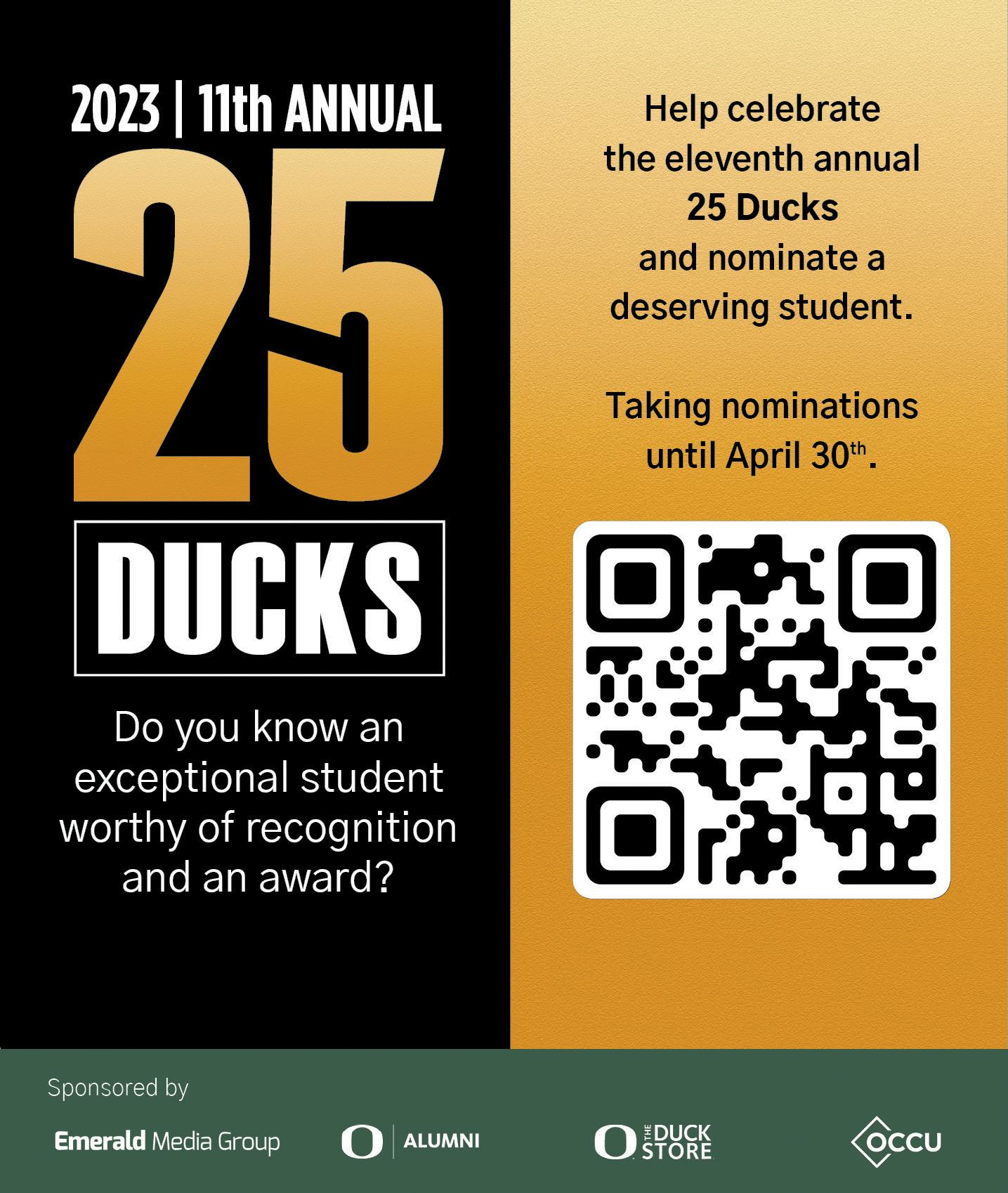
FRIDAY, APRIL 7, 2023 | EMERALD | PAGE 11
IVERSON: DESTIGMATIZE THE COWBOY HAT
Opinion: To my understanding, the immediate assumption of anyone wearing a cowboy hat in public is that they are a redneck or conservative. The history goes deeper than that, and maybe I just want to wear one because.
Yes, I grew up with sidewalks, and no, a chubby bird didn’t yell at the sun to wake me up. When I get hungry, I walk to a Safeway; I don’t slaughter a mammal I accidentally made companionship with. I’ve never gotten used to the smell of manure driving past Corvallis on I-5, I’ve only mowed — not sown — a field and the one time I saddled on a horse, it wandered off into the forest away from our tour guide.
Regardless of these facts, I think I’m an excellent candidate to make wearing a cowboy hat out in public cool again.
I have no qualifications to look like a cowboy, but must that always be necessary? My girlfriend got me this very nice black gambler hat, and it simply deserves to be worn outside of the house. My roommates are confused as to why I just wear it to the kitchen and back to my room.
My only barrier to adding the hat to my standard outwear is the presumption of a cowboy-hatwearing, mustache-bearing white man is that you really shouldn’t ask his opinion on immigration. Understandably so, but I didn’t find the urge to wear a large brimmed hat on Jan. 6. I heard and answered the call to the Old West the same way any person my age did: listening to Marty Robbins and playing “Red Dead Redemption 2.”
Despite my intentions of merely wanting to look like a cowboy and embody my idealized and chimerical version of a time period where parking lots and Dutch Bros. didn’t exist, the stereotype of a cowboy hat wearer is typically that
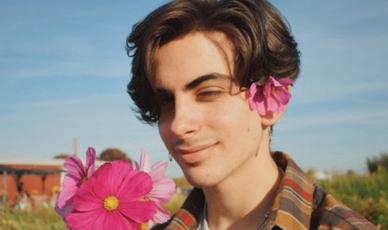 BY BRAYDON IVERSON
BY BRAYDON IVERSON
of a conservative, a redneck or a drunk frat guy.
I’m not sure what image I want to avoid more: David Clarke on Fox News saying the worst combination of words you’ve ever heard or a pledge dumping Coors on their brim while “Party in the U.S.A.” plays in the background. Though with these two images of cowboy hat wearers, I find a middle ground of where I want to be with my hat.
One end of the spectrum sees cowboy hats as a rite of passage; a device to divide yourself from the world that progresses forward that must be earned through living anywhere near a ranch or tractor.
The other end sees the hat as a $10 costume for a themed Friday night rager. Not to sound like an insufferable centrist, but both sides are bad and I’m way smarter than both for acknowledging that.
To me, anyone can wear the hat. Still, wear it right.
Don’t get it trashed and bent and only wear it to throw an imaginary lasso around someone at a dance. Wear it because it’s comfortable, covers your face from the sun and because you just don’t want to look people in the eye that day, like I do. Don’t throw a tantrum because you saw a kid in the city wear a cowboy hat. You and your conservative brethren can still have your pit viper glasses; no one else wants those.
With this conclusion, I decided to finally test the waters on wearing it
out of the house and asked people on campus their opinions on people who wear cowboy hats.
Expectedly, a few people did express concern when they see someone in public who does have one on them. However, many people said they didn’t make that hick assumption of me because of the rest of my outfit being that of a standard college student. A few made the connection that if I went further with the “cowboy look” (i.e boots and blue jeans), then the stereotype would revitalize.
While I think most of the compliments I received felt like people just not willing to hurt my feelings on camera, I felt encouraged that a majority of people didn’t put the “country boy” label on me. Although, I began to wonder why the blue jeans, boots and white tank top redneck was the image they told me to avoid with the hat.
One of the students I talked to was senior Abraham Zepeda, who taught me about the actual roots of the hat I was wearing and where the inspiration of the modern cowboy hat came from.
Vaqueros — Spanish for “cowboy” or “cattle-driver” — inhabited the west of the country, notably in areas like Texas and California, before western settlers colonized the land. While driving the ranch, these vaqueros wore wide circle brimmed hats with a tall crown that look awfully similar in design to the hat I own. That is because John B. Stetson, the creator of the first “cowboy hat” in 1865, was almost
certainly influenced by the design of the sombreros the Mexican cowboys had already been wearing for decades.
“I think some people wear the hat thinking, ‘Oh this is a cool part of my culture,’ when in reality if you go back hundreds of years, it was someone else’s first,” Zepeda said. “For the most part, it doesn’t offend me seeing people wear the hat, but at the end of the day, I think a lot of people are just uninformed about the history of the hat.”
So why is the stereotype of a cowboy hat wearer a problematic hick when hicks are just copying old west cowboys who, in turn, copied the vaqueros? I don’t have the answer to fixing cultural appropriation, but I think I have a pretty good baseline. If you don’t think the descendants of the original cowboy hat wearers have a place in this country, leave the buckaroo hat on the shelf. Let someone cooler wear it.
PAGE 12 | EMERALD | FRIDAY, APRIL 7, 2023 OPINION
Braydon is a second year opinion columnist for the Daily Emerald and fourth year student. Covering sports, student life and broader national trends, sometimes he doesn’t even know if his opinion is genuine or not.
One end of the spectrum sees cowboy hats as a rite of passage.
The other end sees the hat as a $10 costume for a themed Friday night rager.




FRIDAY, APRIL 7, 2023 | EMERALD PAGE 13




PAGE 14 EMERALD | FRIDAY, APRIL 7, 2023
THE PROBLEM WITH THE “GREATER IDAHO MOVEMENT”

The Greater Idaho Movement fails to recognize the dangers and problematic nature of redrawing state lines due to a large cultural divide.
BY ANTONIO MORALES
Anyone who has spent time traveling or living in Oregon has realized the vastness of this state’s urban and rural cultural divide. A 10-minute drive in any direction from any of Oregon’s more populous cities will prove this. In one moment, every store is covered with progressive signs and messages and then boom… Trump merchandise and Confederate insignia glitter Oregon’s rural towns and communities.
It is no surprise that many of these rural communities feel such a strong disconnect from the Democratic majority Oregon State Government. This disconnect is nothing new, as it has been growing over the years as political extremism has exponentially grown since the 2016 presidential election. Political extremism is dangerous no matter which side one falls on. Eastern Oregon, the state’s highest concentration of conservative ideology, feels the biggest detachment to the Willamette Valley’s leadership and left-leaning ideology. Many of its residents have supported Idaho, a conservative majority state government, to completely absorb their counties in a move known as the Greater Idaho Movement.
The Greater Idaho Movement is rural Oregon’s desperate attempt to find cultural reassurance in their state government. In a CNN interview, Kyung Lah spoke with Sandie Gilson, an Eastern Oregon resident and Greater Idaho Movement supporter, who said that they “don’t think the Oregon Government as a whole and the super majority that has been in power for many decades is listening to Eastern Oregon at all.” This disconnect is so strong that Idaho state Rep. Barbara Ehardt (R) co-sponsored a bill to begin dialogue with Oregon to absorb Eastern Oregon counties. In a time of political division, this bill unsurprisingly passed and now stands before the state senate. If this bill is passed by the state senate, Idaho would then be in the process to redraw state lines for the first time since 1864.
Rep. Ehardrt told Kyung Lah in the same CNN segment that she believes that
if these counties are not absorbed into Idaho, then “violence and battle” will ensue internally. As dramatic as that may sound, it is important to emphasize that Eastern Oregon residents do not see a connection to their state government and want to be represented by a state that fits their ideologies. Logically speaking, this makes sense; democratically speaking, this is completely irresponsible and problematic.
In the Idaho House of Representatives, the bill discussing the borders of Oregon and Idaho that has passed onto its state senate makes an interesting point. The bill points out that “the Portland metro area is home to approximately 47% of Oregon’s voters, while accounting for less than 4% of the state’s land mass; WHEREAS, this small urban area is setting policy for the entire State of Oregon and is determining how all people in the State of Oregon, both urban and rural, are governed.”
While this may be understandable, it is wrong to point out that land mass equates to population. This is a repeated conservative rhetorical point that incorrectly represents demographic maps and analysis. It may be true that Eastern Oregon counties contain a conservative majority along with a large percentage of the state’s land mass, but land does not equal people. In a democratically run society it is the people who decide who is in charge. In Oregon’s case, more people live in cities, and their votes are just as important as any Eastern Oregon voter. It makes sense that Oregon has a Democratic majority state government. People are the power, and together they can always be stronger.
Oregonians need to learn to live in harmony with one another as we can find common ground in our shared environment and experiences. We should not give up on unity, and we most definitely should not move forward with the Greater Idaho Movement.
We are all Oregon.
FRIDAY, APRIL 7, 2023 | EMERALD | PAGE 15 OPINION
(Antonio Morales/Emerald)
OREGON GOLF LEADS AFTER ROUND 1 OF 33RD DUCK INVITATIONAL
 BY KEIJI PATTERSON
BY KEIJI PATTERSON
Oregon men’s golf posted the best tournament score with a team 2-under, 287, putting the Ducks atop the team leaderboard following play on day one of the tournament Monday.
The Ducks are five strokes ahead of the second-place Colorado State Rams, who posted a round one score of 3-over, 289, at the 2023 Oregon Duck Invitational at the Eugene Country Club.
Behind the Ducks’ successful first day is senior Nate Stember, who sits in second place with a score of 2-under, 71. Teammates Greyson
Leach, Owen Avrit and Greg Solhaug are nipping at Stember’s heels as they lie within the top 15 of the player leaderboard.
Leach is tied for sixth place after he shot 1-over, 71. Avrit and Solhaug are tied for 11th –– after round one –– as they shot 1-under, 74, and 2-over, 71, respectively. The final member of the starting lineup, Aiden Krafft, struggled Monday as he is 4-over par and is tied for 20th
in Eugene.
Individually, Oregon has eight athletes competing at the Duck Invitational. Daniel Bullen, Eric Doyle, Jay Gould-Healy, Gabriel Hari, Thomas Jenkins Jr., Gian Luca Martinez, Will Stribling and Zikang Zhan make up the Ducks’ individuals.
Redshirt freshman Hari leads the Ducks’ individual players with his round one score of even, 75, which tied him and Krafft on the leaderboard.
The weather and darkness on the course made play difficult on day one. Only six players in the tournament were below par after round one. As the climate issues persisted during round two, the Ducks still maintained a ninestroke lead.
PAGE 16 | EMERALD | FRIDAY, APRIL 7, 2023 SPORTS
Due to a weather warning, day one was cut short after round two suspension.
Oregon men’s golfer Nate Stember watches his chip near the green after hitting from the fairway. (Photo courtesy of Dan Barreto/University of Oregon)
5 YEAR DROUGHT ENDS: OREGON GOLF WINS 2023 DUCK INVITATIONAL
Ducks secured their second straight season victory and first Duck Invite since 2018.
BY KEIJI PATTERSON
In its second consecutive tournament, Oregon men’s golf secured the victory with a team 2-under-par 850. Oregon’s Nate Stember guided the Ducks to success as he shared his championship with Oregon State’s Mateo Fuenmayor with their 6-under 207 scores, over the two day tournament.

This performance was enough to hold off conference rival Oregon State by seven strokes as the Ducks’ went on to win the Oregon Duck Invitational for the first time in five years.
What has become a common theme during this winter season, the Ducks had another round of golf altered due to poor weather conditions.
Round two of the Duck Invitational at Eugene Country Club was suspended until Tuesday morning for darkness/weather concerns.
After a strong first day showing from the Ducks, they maintained their nine stroke lead on day two. Stember continued his first day success, as he birdied three of his last four holes to catapult him up the player standings. However, he wasn’t the only individual in green and black to finish well. Teammates Greyson Leach and Owen Avrit finished their crafty play with scores of 1-over-par 214 each, tied for fifth place. Greg Solhaug shot 5-over-par 218, while Aiden Krafft shot 7-over-par 220.
Stember, Avrit, Leach, Solhaug and Krafft placed in the top 20 in individual scoring, making Oregon one of two programs [Oregon State] to have its five starters finish in similar fashion.
Oregon head coach Casey Martin discussed Stember’s practice availability last week.
“We weren’t sure if Nate was going to be able to go. He didn’t pick up a club… all week,” Martin said. “… He decided to tough it out and then he wins the tournament.”
Martin was ecstatic about his pupil’s perseverance that led to his victory.
The rest of Oregon’s players competing individually showed promise. Freshman Jay Gould-Healy led his peers in the final round with an even-par 71. Gould-Healy finished No. 50 with teammate Thomas Jenkins Jr, who shot 15-over-par 228, respectively. Eric Doyle and Gabriel Hari were the two highest individual competitors for the Ducks as they placed tied for No. 18 and 33 each. Doyle shot 7-over-par 220, while Hari maintained his day one tournament play with 11-over-par 224 performance.

FRIDAY, APRIL 7, 2023 | EMERALD | PAGE 17 SPORTS
Oregon men’s golfer Owen Avrit looks up at his swing after hitting the ball with his driver. (Photo courtesy of Dan Barreto/University of Oregon)
A golfer for the University of Oregon prepares to hit a putt. The Eugene Country Club hosted the Pac-12 women’s golf championships from April 18-20, 2022. (Will Geschke/Emerald)




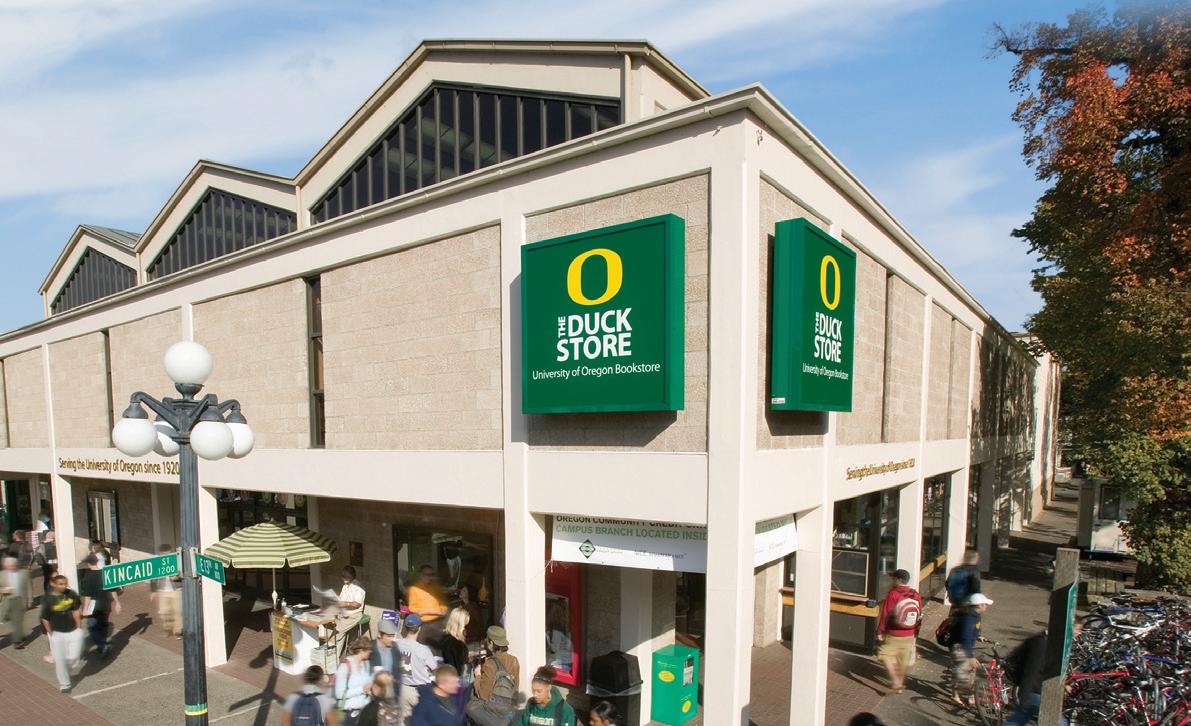

PAGE 18 | EMERALD | FRIDAY, APRIL 7, 2023 SPRING TERM TEXTBOOKS ONLINE ONLY Findyouwhatneed! UODuckStore.com/books Important: Textbooks are available online only Orders available to pick up by the next business day FREE In-Store Pickup, plus FREE shipping on orders $50 or more* IN-STORE PICKUP Remember: Textbooks and ebooks are available online only. Most orders ship FREE* from The Duck Store, or choose In-Store Pickup from our Flagship Campus or EMU locations! * Free shipping available on orders of $50 or more and applies to standard shipping anywhere in the U.S. including Alaska & Hawaii.




FRIDAY, APRIL 7, 2023 | EMERALD | PAGE 19
Q&A WITH BETSY BONNER
The UO professor talks about her writing and the magic of Sylvia Plath.
BY PHILIP CHAN
The first teaching job Betsy Bonner had was abroad, on the Greek island of Paros. Since then, the poet and memoirist has taught children at a private school in Connecticut and the elderly in a remote memoir-writing class. Today, Bonner is teaching poetry to Ducks as a visiting assistant professor in the University of Oregon’s creative writing program.
Bonner moved to Eugene in September. Faculty hired her based on the beautiful, elegiac quality of her poetry, according to Daniel Anderson, professor of poetry and director of the creative writing program. The faculty was also impressed by Bonner’s 2020 memoir “The Book of Atlantis Black,” which explores the mysterious death of her sister. NPR praised it as one of the best books of the year. Bonner spoke to the Emerald about her life and her work in late February at her office in the Alder Building.
This interview has been edited for brevity and clarity.
Emerald: What compelled you to write the memoir “The Book of Atlantis Black”?
Bonner: There were a few different things. I distinctly remember being in a writing group with two other women in New York, who I knew through the 92Y [cultural center]. What I was writing was an attempt to be seeing through my sister’s eyes in this hotel room where she was said to have died, about which I’ve read report after report, but of course I wasn’t there. And why was this in my poem? Those two women saw what I was doing. It wasn’t going to fit into a poem. I also remember when I would be trying to write a poem, I would have these childhood memories that seemed to be sentences, not poetry. There was so
much and there is still so much that I couldn’t understand. Prose can at least seem sensible. That story needed to find that form. It’s not that I set out to write a memoir. It’s more like it was not going to work in poetry, the narrative itself.
Emerald: When you sit down to write, do you have any routines or rituals that help you get going?
Bonner: I love that you say “sit down” because I actually write a lot in bed. And I love to write by hand. With prose, I composed on the computer more, but I wrote a lot of the beginnings of chapters that became my memoir by hand. I wrote a lot in the morning and in the beginning of the day. With poetry, I like to write at night. I wake up in the night. I like to read and sometimes I’ll be inspired enough to write in the middle of the night, especially in my 20s. When it was warmer out, I was going to the coast as much as I could. It’s nice to be near water. That could be considered part of the ritual, getting some kind of experience outside of the city, to get inspiration for writing.
Emerald: As a teacher yourself and having worked with some great poets, what do you think makes a great teacher?
Bonner: They have to listen. They have to see you. Accessibility, certainly.
Emerald: I know Sylvia Plath is a poet whom you love. What do you think makes her work so accessible and so popular?

Bonner: We just read “Lady Lazarus” by Plath in my intermediate class, and that was specifically because a student’s workshop poem that week had a line from “Lady Lazarus.”
I think the voice absolutely is what attracts readers to Sylvia Plath, the rage as well, the fury. But most of all the voice, even as she wrote in a persona here and there. Her voice comes through. And the intrigue around her life and her suicide, especially for high school students who read “The Bell Jar.” We all know it’s a novella drawn from her own personal life, and if it were to be published today, I’m sure it would have been called a memoir. It’s interesting how she seems accessible, even though her language is wild. I would guess that it has to do with the voice and also just the magic of — she was a real poet.
At the end of spring term, Bonner’s contract with UO will be up. She will continue teaching remote classes through the 92nd Street Y cultural center and is working on another book. She will move back to Vermont to live with her partner and their two cats, Maggie and Murphy.
To learn more about Betsy Bonner, visit www. dailyemerald.com for an in-depth profile.
PAGE 20 EMERALD | FRIDAY, APRIL 7, 2023 A&C
Photo courtesy of Betsy Bonner

FRIDAY, APRIL 7, 2023 | EMERALD PAGE 21



PAGE 22 | EMERALD FRIDAY, APRIL 7, 2023
Our Mission
To serve the University of Oregon community with independent student journalism in the public interest.






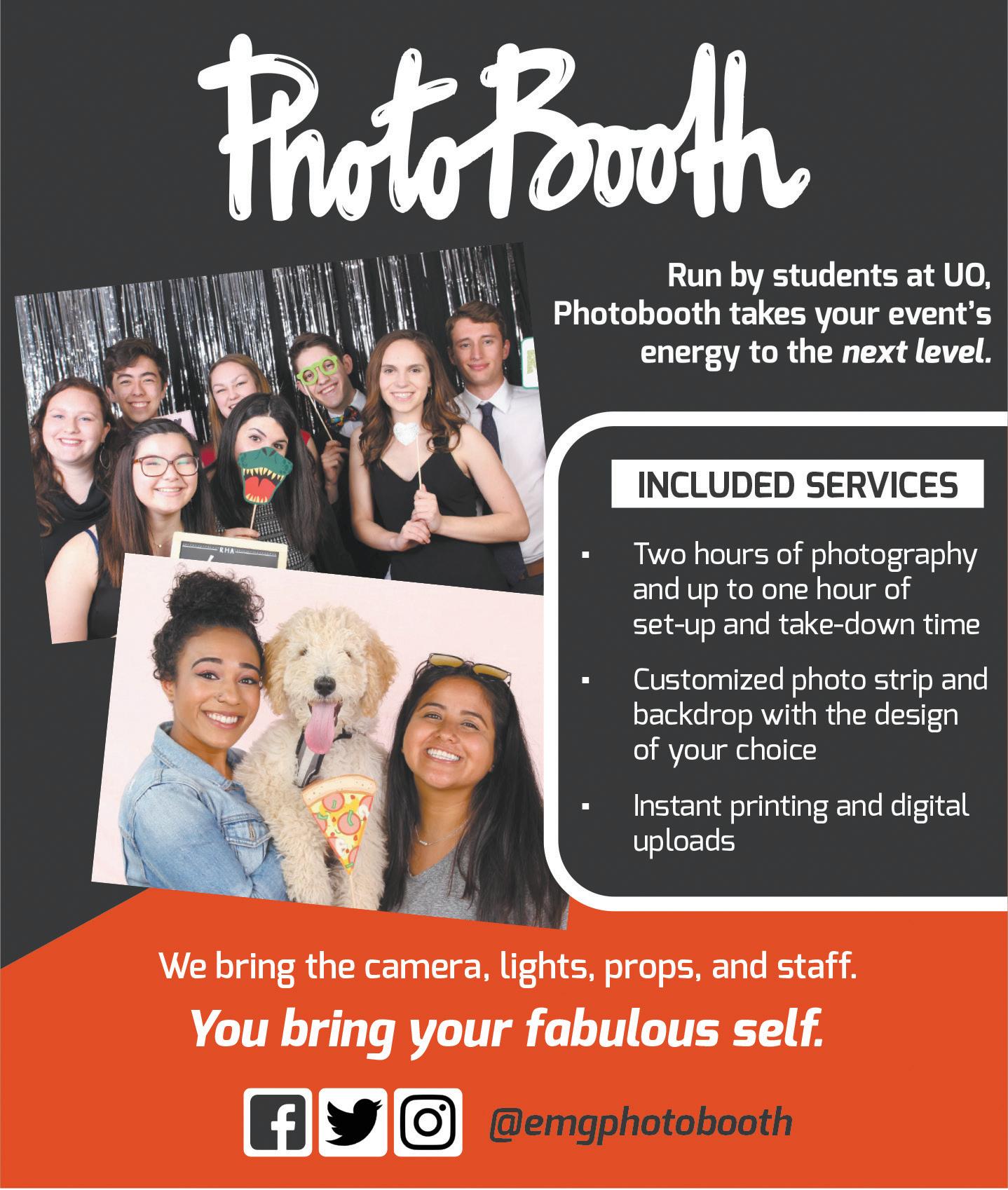
To train students to professional standards and provide networking opportunities that make them coveted job candidates.
To ensure the long-term nancial viability of an independent student media company.





The Daily Emerald is UO’s student-run, independent and awardwinning weekly newspaper. We cover everything on the UO campus. Our weekly print editions and daily online content includes visual stories, multimedia, news, A&C, sports and opinion.


dailyemerald.com/ dailyemerald.com/ethos greeneugene.com/ @DailyEmerald @EthosMag @GreenEugeneMag
Ethos Magazine is a quarterly news magazine. Our mission is to elevate the voices of marginalized people who are underrepresented in the media landscape, and to write in-depth, human-focused stories about the issues a ecting them.
@DailyEmerald @ Ethos.Mag @ GreenEug


Green Eugene is a leader in the growing eld of college-based cannabis magazines. The team of student writers, photographers and designers work to break stigma, address systemic injustices, educate, and entertain while building meaningful connections with the local cannabis community.

FRIDAY, APRIL 7, 2023 | EMERALD | PAGE 23
To learn more visit dailyemerald.com/emg/ @DailyEmerald @EthosMag @GreenEugeneMag

PAGE 24 | EMERALD FRIDAY, APRIL 7, 2023












 BY MATHIAS LEHMAN-WINTERS
BY MATHIAS LEHMAN-WINTERS













 BY BRAYDON IVERSON
BY BRAYDON IVERSON









 BY KEIJI PATTERSON
BY KEIJI PATTERSON

























